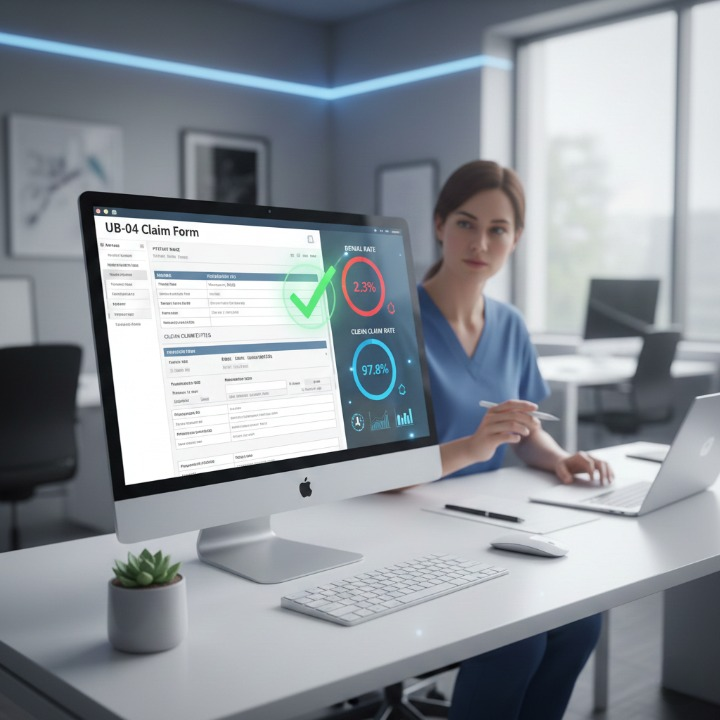The 2025 Guide to Clean Claims
Clean Claims Medical Billing in 2025
Clean Claims Medical Billing in 2025 is more important than ever. As regulations tighten and payers demand accuracy, healthcare providers must ensure claims are submitted error-free the first time.
How to Improve First-Pass Resolution Rates
Processing clean claims efficiently has never been more critical in healthcare billing. For billing professionals and administrators, ensuring a high First-Pass Resolution Rate (FPRR) is key to optimizing revenue and minimizing delays. But achieving clean claims can be complex in today’s rapidly evolving landscape of regulations, technologies, and patient care expectations.
This guide will walk you through everything you need to know about clean claims, why improving your FPRR matters, and how adopting best practices can transform your billing process in 2025.
What Are Clean Claims in Medical Billing 2025 and Why They Matter
A clean claim is error-free, contains accurate information, and meets all payer requirements on the first submission. Clean claims are processed and paid without additional follow-up or resubmission, saving time and resources.
Clean claims are essential for maintaining cash flow, ensuring compliance, and avoiding hefty penalties from denied claims. With Medicare claims often needing to meet a 95% benchmark for resolution rates, the stakes are particularly high for healthcare organizations.
Did you know?
The average national FPRR for claims currently hovers between 75% and 85%. However, top-performing organizations aim for 95% or higher to maintain financial stability.
Understanding First-Pass Resolution Rate
FPRR is the percentage of claims accepted and processed by payers on the first submission without requiring manual intervention for errors or resubmissions. It’s a critical metric in evaluating your revenue cycle’s efficiency.
Benchmarks for First-Pass Resolution Rates in 2024:
- National Average: 75-85%
- Medicare Claims: 95% due to strict requirements
- Commercial Insurance Claims: 70-90%
- Warning Sign: An FPRR below 70% highlights significant inefficiencies needing immediate resolution.
Common Reasons for Claim Denials in 2024
Staying ahead of claim denials starts with understanding why they happen. Here are the most common causes to watch for:
- Coding Errors: Incorrect or outdated ICD-10 and CPT codes.
- Incomplete Information: Missing patient details, diagnosis, or authorization.
- Invalid Provider Credentials: Failure to adhere to payer-specific credentialing rules.
- Overlapping or Duplicate Claims: Submitting multiple claims for the same service.
- Failure to Follow Compliance Regulations: Violations of HIPAA or ignoring NCCI edits.
Clean Claims Medical Billing: Best Practices for Accurate Coding in 2025
Accurate data and correct coding are non-negotiable for improving clean claim submissions. Here’s how to stay on top of your game:
- Verify Patient Information: Ensure all data is current, including insurance details and demographics.
- Standardize Documentation: Use clear templates to reduce ambiguity during data entry.
- Use Up-to-Date Codes: Regularly update your system with the latest ICD-10 and CPT codes.
- Implement Double Checks: Add a final review layer to audit claims before submission.
Leveraging Technology for Automated Claim Scrubbing
Technology has revolutionized the ability to spot errors before claims reach payers. Automated claim scrubbing identifies issues like coding inaccuracies, incomplete fields, or mismatched data in real-time to maximize efficiency.
Key Benefits of Technology in Claims Processing:
- Fewer Errors: Catch mistakes instantly before submission.
- Improved Accuracy: Consistently apply coding and payer-specific edits.
- Scalability: Process high claim volumes with ease, freeing staff from redundant tasks.
Case in point: St. Luke’s Hospital adopted automated claim scrubbing and saw its FPRR jump by 20% within six months.
Training and Education for Billing Staff
Even with the best technology, errors still occur without proper training. Knowledgeable billing staff can interpret trends, identify problem areas, and execute solutions effectively.
Training Tips to Reduce Claim Denials:
- Offer regular workshops on coding and compliance.
- Maintain updated resources for payer requirements.
- Use real-world examples of common errors and how to troubleshoot.
Consider the results from the Community Health Clinic, which conducted comprehensive staff training. They reduced errors related to coding by 35% in less than a year.
Focus on Compliance in Claims Processing
Compliance isn’t just a checkbox—it’s an integral part of managing clean claims. Non-compliance with regulations like HIPAA or ICD-10 can jeopardize reimbursements and expose organizations to audits or fines.
How to Strengthen Compliance:
- Upgrade Security Measures: Ensure all patient data is encrypted and handled securely to meet HIPAA guidelines.
- Follow Coverage Guidelines: Pay attention to LCDs and NCDs to align claims with payer-specific rules.
- Monitor OIG Updates: Stay informed of the Office of Inspector General’s focus areas to avoid compliance pitfalls.
Example: Regional Medical Group adopted compliance-focused strategies and reduced compliance-related denials by 15%.
Future Trends in Healthcare Claims Processing
Looking forward, healthcare billing continues to evolve with cutting-edge technologies and new care models. Here are some trends reshaping the future of claims processing:
- AI and Machine Learning: Predictive analytics will reduce errors while enabling intelligent claim routing.
- Blockchain Technology: Enhanced security and transparency in data sharing and payment tracking.
- Real-Time Adjudication: On-the-spot validation and payment at the point of service.
- Telehealth Claims: Streamlined processing for telehealth appointments as remote care expands.
- Value-Based Care Models: Aligning claims processing with quality outcomes instead of service volume.
Key Takeaways and Next Steps
Improving your FPRR and achieving clean claims is a marathon, not a sprint. By incorporating technology, training your teams, staying compliant, and monitoring trends, you can move closer to an optimized claims process.
Your next steps:
- Evaluate your current FPRR and identify improvement areas.
- Conduct an audit to analyze denial patterns.
- Automate claim scrubbing and integrate AI tools.
- Train billing teams on compliance and coding best practices.
If you’re ready to transform your billing process, we’re here to help. Download our free guide to clean claims today, or contact our experts for a personalized consultation to take control of your revenue cycle










